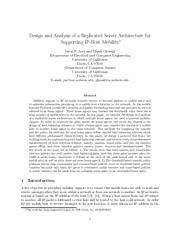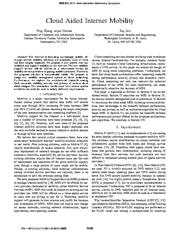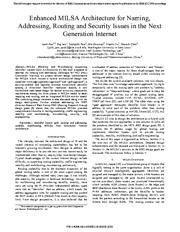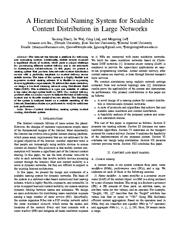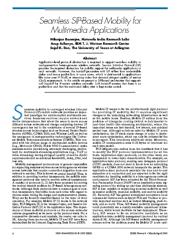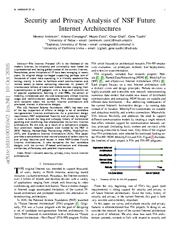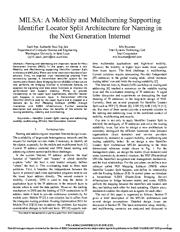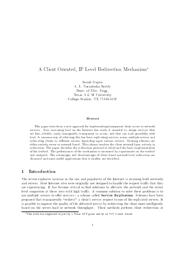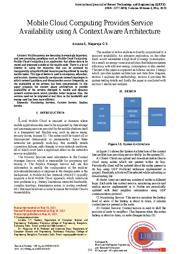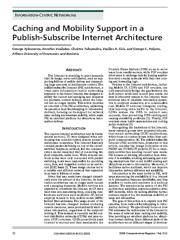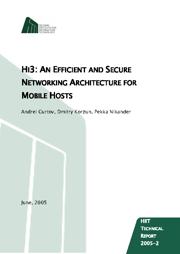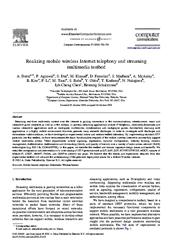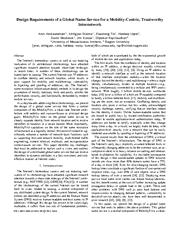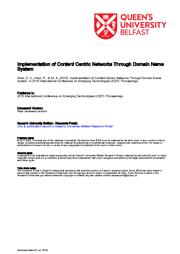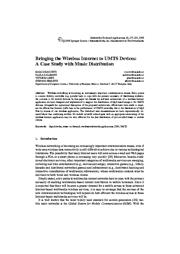A copy of this work was available on the public web and has been preserved in the Wayback Machine. The capture dates from 2017; you can also visit the original URL.
The file type is application/pdf.
Filters
Design and analysis of a replicated server architecture for supporting IP-Host mobility
1998
ACM SIGMOBILE Mobile Computing and Communications Review
In this paper, we consider the design and analysis of a replicated server architecture in which multiple home agents are used to provide mobility support. ...
Mobility support in IP networks requires servers to forward packets to mobile hosts and to maintain information pertaining to a mobile host's location in the network. ...
In the mobile-IP protocol 1], this support is provided by two servers: the foreign agent and the home agent. ...
doi:10.1145/1321387.1321388
fatcat:7yskmlni7vfedmykfjiolbbf7u
Cloud aided Internet mobility
2013
2013 IEEE International Conference on Communications (ICC)
We propose a new system that can facilitate and support mobility on the Internet. ...
Furthermore, we explore the architectural tradeoffs among QoS, economic viability, security and privacy of various cloud aided designs. ...
ACKNOWLEDGMENTS This work was supported by the National Science Foundation under Grants No. 1019120, 1019119, 1138659, 1249678. ...
doi:10.1109/icc.2013.6655127
dblp:conf/icc/0017DJ13
fatcat:oxj3aq2vmvefjami4ur2xxvuc4
Enhanced MILSA Architecture for Naming, Addressing, Routing and Security Issues in the Next Generation Internet
2009
2009 IEEE International Conference on Communications
MILSA (Mobility and Multihoming supporting Identifier Locator Split Architecture) [1] has been proposed to address the naming and addressing challenges for NGI (Next Generation Internet). we present several ...
design enhancements for MILSA which include a hybrid architectural design that combines "core-edge separation approach" and "split approach", a security-enabled and logically oriented hierarchical identifier ...
DESIGN ENHANCEMENTS AND RATIONALE ANALYSIS Several design enhancements to MILSA architecture are analyzed and discussed in this section.
A. ...
doi:10.1109/icc.2009.5198998
dblp:conf/icc/PanJPBXC09
fatcat:xnbu6sj6rbej7pibopkr4eyacq
A hierarchical naming system for scalable content distribution in large networks
2013
2013 IEEE Wireless Communications and Networking Conference (WCNC)
To achieve fast name resolution, we design a two-level indexing network using Distributed Hash Table ( DHT). This architecture is open and scalable. ...
Additionally, mobile devices consume a significant chunk of content, which poses a unique challenge for provisioning efficient content delivery and is not addressed in contemporary infrastructures. ...
Host and content mobility is a norm in dynamic networks, but they are difficult to support in the existing Internet architecture. ...
doi:10.1109/wcnc.2013.6555348
dblp:conf/wcnc/Zhao0LL13
fatcat:qn25fx7lafejdhcnfwu2ikrwhi
Seamless SIP-based mobility for multimedia applications
2006
IEEE Network
Acknowledgments This work is partially supported by the PSI project (NSF ITR grant no. IIS-0326505) at UT Arlington and ORBIT project (NSF NRT grant no. ANI-0335244) at Rutgers University. ...
SIP architecture and mobility support: a) SIP architecture; b) SIP-based mid-call terminal mobility management. redirect servers for SIP service discovery or to determine the current bindings of the SIP ...
For example, a multicast-based architecture for host mobility [7] was proposed to reduce handoff delay and minimize packet loss. ...
doi:10.1109/mnet.2006.1607890
fatcat:unj5hiu435fpba3n5qip3s35ey
Security and Privacy Analysis of NSF Future Internet Architectures
[article]
2016
arXiv
pre-print
Its original design envisaged supporting perhaps tens of thousands of static hosts operating in a friendly academic-like setting, mainly in order to facilitate email communication and remote access to ...
National Science Foundation (NSF) has been one of the key supporters of efforts to design a set of candidate next-generation Internet architectures. ...
Third, GNRS does not statically give the authority to a replicated server for a specific set of names. ...
arXiv:1610.00355v2
fatcat:2iybd7qinzaovh3m2m653nlczi
MILSA: A Mobility and Multihoming Supporting Identifier Locator Split Architecture for Naming in the Next Generation Internet
2008
IEEE GLOBECOM 2008 - 2008 IEEE Global Telecommunications Conference
Further scenarios description and analysis show the benefits of this scheme for routing scalability, mobility and multihoming. ...
Naming and addressing are important issues for Next Generation Internet (NGI). In this paper, we discuss a new Mobility and Multihoming supporting Identifier Locator Split Architecture (MILSA). ...
Mobility is achieved in two ways: UPDATE packets and rendezvous servers. First way is simple but it doesn't support simultaneous movement for both end hosts. ...
doi:10.1109/glocom.2008.ecp.436
dblp:conf/globecom/PanPJB08
fatcat:pfx34m4ucfchlgxqiherbgdb44
A client oriented, IP level redirection mechanism
1999
IEEE INFOCOM '99. Conference on Computer Communications. Proceedings. Eighteenth Annual Joint Conference of the IEEE Computer and Communications Societies. The Future is Now (Cat. No.99CH36320)
A common way of achieving this has been replicating services across multiple servers and redirecting clients to di erent servers depending upon various criteria. ...
This paper introduces a new approach for implementing transparent client access to network services. ...
Mobile IP Implementations Most proposed schemes and implementations share a common approach to IP mobility. A mobile host has a constant home IP address regardless of its current location. ...
doi:10.1109/infcom.1999.752167
dblp:conf/infocom/GuptaR99
fatcat:xnxaj54fojdoldfpe2nwgdb23u
Mobile Cloud Computing Provides Service Availability using A Context Aware Architecture
2021
International journal of recent technology and engineering
In this paper proposes the context aware architecture to provide availability of the services deployed in mobile and dynamic network environments which provides better response time, the services need ...
There is a lot of interest in using the resources that can be accessed by transparently using distributed resource pooling offered by nearby mobile nodes. ...
DESIGN
Figure 2.1: System Architecture In figure 2.1 shows the System Architecture of the context free architecture providing service ability for the system [2] . ...
doi:10.35940/ijrte.a5924.0510121
fatcat:rregiycfl5ftrprll3t56j5nom
Caching and mobility support in a publish-subscribe internet architecture
2012
IEEE Communications Magazine
Patches to the Internet architecture, including Mobile IP, CDNs and P2P overlays, can only superficially bridge the gap between the host-centric model and current user needs. ...
In the remainder of this article we first outline the PSI architecture and then explain the design of a PSI network. We proceed to explain how caching operates in PSI, and then focus on mobility. ...
Patches to the Internet architecture, including Mobile IP, CDNs and P2P overlays, can only superficially bridge the gap between the host-centric model and current user needs. ...
doi:10.1109/mcom.2012.6231279
fatcat:rhhzprvfmzce3ch5s5zisg7kaq
Hi3: An efficient and secure networking architecture for mobile hosts
2008
Computer Communications
The Host Identity Indirection Infrastructure (Hi 3 ) is a networking architecture for mobile hosts, derived from the Internet Indirection Infrastructure (i 3 ) and the Host Identity Protocol (HIP). ...
Both our analysis and early measurements support the notion that Hi 3 performance is on the same level with Mobile IP. ...
Acknowledgments The authors want to thank Jari Arkko, Börje Ohlman, Jukka Ylitalo, Heikki Mahkonen and Jan Melen for fruitful discussions on this problem space. ...
doi:10.1016/j.comcom.2008.03.014
fatcat:7v2ztnlknrejjclocrjqz4q7se
Realizing mobile wireless Internet telephony and streaming multimedia testbed
2004
Computer Communications
We detail the incorporation and inter-relation of a wide catalog of IETF protocols-such as SIP, SAP, SDP, RTP/RTCP/RTSP, MGCP, variants of Mobile-IP, DRCP, HMMP, PANA, and DSNP-to achieve our goals. ...
We believe that the results and experiences obtained from this experimental testbed will advance the understanding of the pertinent deployment issues for a Mobile Wireless Internet. ...
Acknowledgements Authors would like to acknowledge other contributing ITSUMO members, Ted Lu, Aileen Cheng, Parmesh Ramanathan of University of Wisconsin, Xiaotao Wu and Jonathan Lennox of Columbia University ...
doi:10.1016/j.comcom.2003.10.012
fatcat:y7muvvl4kfcohh3maid7m3p2eu
Design requirements of a global name service for a mobility-centric, trustworthy internetwork
2013
2013 Fifth International Conference on Communication Systems and Networks (COMSNETS)
The current Internet uses IP addresses to conflate identity and network location, which results in poor support for mobility and multihoming; vulnerability to hijacking and spoofing of addresses, etc. ...
As a step towards addressing these shortcomings, we present the design of a global name service that forms a central component of the MobilityFirst, a clean-slate Internet architecture with mobility and ...
With roughly 5 billion mobile devices worldwide today [19] (over a billion of which are IP-capable) compared to barely a billion tethered hosts [11] , mobility and multihoming are the norm, not an exception ...
doi:10.1109/comsnets.2013.6465579
dblp:conf/comsnets/VenkataramaniSTUWKR13
fatcat:bv2xcioarna2pb6ebqrxqrqefm
Implementation of Content Centric Networks through Domain Name System
2015
2015 International Conference on Emerging Technologies (ICET)
retrieval of contents, supporting host mobility, disruption and multi-homing. ...
Mobility Proposed DNS architecture support the client mobility as well. Because the focus is on the content location instead of the host location. ...
doi:10.1109/icet.2015.7389212
fatcat:5kzrutis5zdh7gfu7elcup2uvy
Bringing the Wireless Internet to UMTS Devices: A Case Study with Music Distribution
2005
Multimedia tools and applications
In this paper we discuss the software architecture of a wireless Internet application we have designed and implemented to support the distribution of Mp3-based songs to 3G UMTS devices. ...
effective for the fast distribution of pre-recorded music to mobile clients. ...
testing of the software architecture discussed in this paper. ...
doi:10.1007/s11042-005-5606-z
fatcat:zfu242ycf5divoasa4gli4tpqm
« Previous
Showing results 1 — 15 out of 6,515 results

